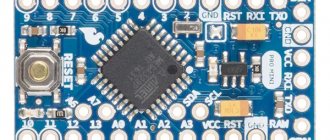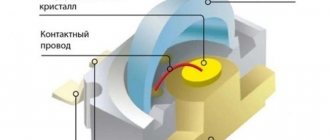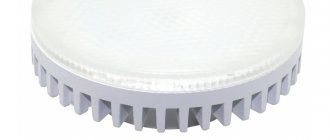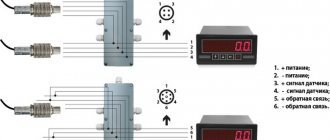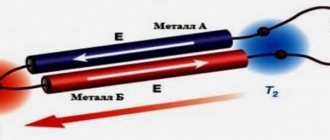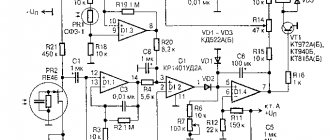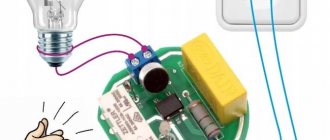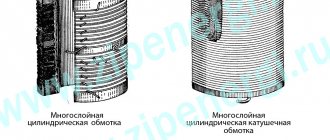Conventional LEDs occupy leading positions in modern lighting systems for various purposes. Multicolor RGB devices are no less popular today. The light, colored in various shades, is ideal for decorative design of architectural elements, artistic lighting of landscape and interior items. Thanks to the ability to connect RGB LEDs to various control devices and combine them into large-scale groups, they create spectacular lighting scenarios and equally impressive moving images.
What is an RGB LED?
The device is a full-color LED element capable of reproducing the entire spectrum of rainbow colors. Unlike conventional LEDs, it has three independent light sources that emit light in three basic colors - Red, Green and Blue.
Characteristics of RGB LED
The operation of the device is based on the optical effect of creating different shades by controlled mixing of 2-3 primary colors. Combination is possible in different order and ratio. To create the desired shade, a change in the brightness of each individual crystal is used. Using the basic characteristics of RGB LEDs, you can create interesting lighting effects by mixing colors, alternately switching on individual conductors, and changing shades in the desired sequence. When all 3 semiconductors are operating at full power, the diode emits white light.
Connection diagrams for two-color LEDs
To make an electrical appliance with your own hands, you need to know how to connect a two-light LED. The simplest (but not entirely correct) option is to connect power to the legs through a resistor and determine the on/off cycles.
To add a resistor to the circuit, you need to calculate its resistance and power values.
Since 2015, GOST 29433-2014 has defined new power supply voltage parameters:
- nominal 230 V;
- minimum 207 V, under load 198 V;
- maximum 253 V.
The resistance of the resistor must be of such a value that the current necessary for the normal functioning of the two-color LED can flow through it, but the element does not overheat. Therefore, the rated current value of 20 mA for calculations is replaced by another value - 7 mA = 0.007 A, which allows the diode to glow normally.
Resistance:
You need to buy a 33 kOhm element.
Resistor power:
You need to buy a 2 W element.
To check, the current at maximum voltage is calculated:
Power:
This means that a 2 W resistor will not overheat even at the maximum network voltage.
Attention! If a two-color LED has 2 pins, it is connected using one resistor. If there are three terminals, 2 resistors are required, the resistance is calculated separately for each (the current is different for crystals with different colors).
On timer 555
The 555 timer is an integrated device that generates pulses at certain intervals. Models are available in plastic and metal DIP and SMD housings for 4.5 – 16 V. The main area of application in everyday life is the control of three-color strips and lamps. Timer 555 turns on the colors one by one. The standard supply voltage is 5 V, you can convert it to 12 V by changing the resistance of the resistors.
How multicolor LEDs work
RGB LED modules have a characteristic design - three color diodes installed on one matrix and covered with a single optical lens. A flexible tape or a rigid matrix with a three-layer structure is used as a base. Each crystal has a separate connection to the power supply. Accordingly, the RGB LED has 4 contacts - one common and one per semiconductor.
Three-color LED lamp
Once they asked me to make a lamp that could change colors, because a monochromatic one can get boring pretty quickly: in short, something like a night light.
Of course, the lighting method described in this article is also well suited for internal lighting of a computer, therefore this article may be of interest both from the point of view of design ideas and for fans of modding.
I somehow didn’t want to make a regular three-color lamp using toggle switches and three LEDs, because it’s much more interesting when the number of colors is not limited by the number of LEDs.
Necessary materials:
- Three-color super-bright RGB LED with a diameter of 8 mm with a brightness of about 4000 mCd (or 3 super-bright LEDs with a diameter of 3 - 5 mm: blue, green, red).
- Variable resistors 0 - 1.5 kOhm with load switching off - 3 pcs.
- Four-wire wire
- Plexiglas cube 30x30x30 mm
- Radio housing
- 3 knobs for adjustment
- A plastic bottle cap (or a magnet from a PC speaker)
- Adjustable power supply (if you will be powering this device from a computer, take either a USB cable or a power splitter (molex))
- Heat shrink or insulating cambrics
- Black electrical tape
Tools:
- Engraver (aka Dremel) - in principle, you can do without it
- Glue gun
- Set of files
- Drill
- Awl
- Files
- Sandpaper
- Pliers
- Side cutters
- Pistol knife
- Lighter
- A little imagination
So let's get started.
First, let's look at a three-color LED. It has 4 pins: common (+) and 3 legs responsible for color. By connecting the minus to one of the legs, the LED will glow either blue, green, or red. It looks like this:
If you look closely, you can see that one of the legs inside the LED housing has a T-shape - this is the common (+). In the photo, the legs are from left to right: red (-), general (+), blue (-), green (-). If you do not find a three-color LED on sale, you can replace it with three single-color LEDs by soldering their positive legs together.
In essence, the desired color of the lamp can be achieved by changing the brightness of each of the three colors of the LED, which will shine simultaneously from under one lampshade and, merging into one color, will give the one we need.
Principle of operation
Such devices are created and operate using COB technology. They have several identical pn junctions. When voltage is applied to one crystal, charge recombination results in a glow of a certain color. When 2-3 elements are turned on simultaneously at a certain power, a secondary glow of the phosphor appears with the formation of various shades. So, when the red and green crystals are turned on in pairs, the RGB LED will produce yellow light. Simultaneous activation of blue and green will produce a turquoise tint.
Operating principle of two-color LEDs
The operating principle of elements with two terminals is simple. The color of the glow changes simultaneously with the change in the polarity of the connection. This means that the color depends entirely on which path the current takes. When a plus is applied to one of the terminals, one crystal begins to glow, the second is locked. After changing the polarity, the locked one begins to glow, the luminous one is locked.
This circuit is used in indicators operating on alternating voltage. Two-color diodes are connected in parallel and counter, the current is limited by one resistor. Such elements are often mounted in push-button switches, with the help of which the color of the glow changes.
Since the color of the LEDs is unsaturated and dim, when mixed, a shade is formed that is difficult for humans to determine. Another feature is the change in shade when looking at the light source from different angles.
Kinds
RGB LEDs are available in various designs, which allows you to choose the optimal device for various purposes. The device can be equipped with a transparent or frosted lens. These devices also have different housing designs - a standard round one, a high-power Emitter model and a Piranha format module.
The main classification of RGB LEDs is based on the type of crystal connection inside:
- with a common cathode (CA) - control is carried out by applying a signal of positive polarity to the anode;
- with a common anode (CC) - changing operating modes is carried out by applying a negative pulse to the cathode;
- with independent elements - each crystal has its own pair of contacts (6 pins in total), suitable for switching in various ways.
Reasons for the dependence of parameters on the standard size
Of course, the dimensions of the case indirectly affect, for example, such a parameter as the maximum permissible power supplied to the LED. Or on the supply voltage (a larger package can accommodate more crystals connected in series). But can they have an impact on, say, the color rendering index? And, if so, what causes this influence?
In addition to the already mentioned physical parameters, which directly depend on the size of the LED housing, there are at least two more factors that determine its characteristics. Firstly, this is the application for which SMD LEDs of this size were originally developed. The situation in the lighting market is changing rapidly. For example, we developed good SMD LEDs specifically to replace fluorescent lamps, but then there was an overproduction of retrofits. Then, instead of retrofits, these LEDs go into lamps. Secondly, the time of appearance of this standard size on the market. For SMD LEDs, each standard size is strictly tied to technological processes. Moreover, for a certain standard size, these processes are practically the same for different manufacturers. If the technology has been improved, then, as a rule, the dimensions of the case have changed, at least by a fraction of a millimeter. It is this circumstance that makes it possible to indicate their standard size as the main parameter of LEDs in the data on lamps.
To reduce the cost of finished products, companies producing lamps practice purchasing SMD LEDs from different manufacturers, which are currently cheaper. Different batches of a luminaire of the same model may use LEDs of different origins, but their standard size remains unchanged.
Let's look at the most common sizes of SMD LEDs and their inherent features.
SMD 3528
The most “ancient” standard size of SMD LEDs appeared in the mid-2000s. It was originally developed for backlighting LCD matrices, for which it is still used today. It was on his example that technologies were transferred from the backlight of LCD matrices to lighting.
Due to design features, the power of SMD 3528 is limited to 0.1 W
There is only one die inside the SMD 3528 LED, so the forward voltage drop for a white LED ranges from 2.8 to 3.5 V. The package typically has two terminals.
The disadvantage of 3528 LEDs is poor heat dissipation from the crystal. In fact, heat dissipation is only possible into the air flowing around a small case, as well as into the board through solder connections, but the size of the contact pads is also very small. All these circumstances limit the power supplied to the LED to 0.1 W.
The main advantage of size 3528 is the exceptional low cost of LEDs. This is mainly due to the fact that long-existing production lines are used, the costs of which have already been recouped many times over. In this case, as a rule, obsolete technologies are used, which is why the light output of such LEDs is about 70 lm/W.
The optimal use of SMD 3528 in lighting technology is LED strips for decorative lighting. The small dimensions of the housing, combined with low cost, make it possible to place LEDs on a strip with high density, as a result of which, when viewed from afar, the LEDs merge into a continuous line.
SMD 3528 LEDs are a good choice for decorative LED strips
But for powerful lighting strips, lamps, and retrofits, size 3528 is not suitable, although it is used in the cheapest products from little-known manufacturers. Usually, to achieve acceptable parameters for the lamp, SMD 3528 LEDs are “overclocked,” that is, they are put into a forced mode not intended by the developers. The downside of “overclocking” is the reduction in LED service life compared to that stated by the manufacturer.
SMD 2835
However, the LED dimensions of 3.5 x 2.8 mm turned out to be convenient for strips and retrofits. As a result, in 2011, a housing design for such an LED was proposed, characterized by reduced thermal resistance (4°C/W). This case has larger contact pads, which ensures effective heat exchange with the board. The bottom surface of the housing is flat; in some LED models, in addition to the contact pads through which power is supplied, there is also a contact pad for the heat sink.
Size 2835 is suitable not only for strips, but also for office luminaires
The new standard size was called SMD 2835. That is, the dimensions are the same, but the changes are reflected by rearranging two groups of numbers in the designation.
The maximum input power for size 2835, depending on the modification, can range from 0.2 to 1 W. Light output is about 100 lm/W.
Usually there is only one crystal in the 2835 package, but for high-power LED strips, SMD 2835 LEDs are produced with crystals connected in series; the forward voltage on such an LED is 9-10 V.
The main purpose of SMD 2835 LEDs is retrofits and powerful lighting strips. There are successful examples of using this standard size in inexpensive office lamps.
SMD 5050
The case size was increased to 5x5 mm, which made it possible to place three crystals in it. The case has six pins, that is, each LED has its own pair of pins. Available in white or monochrome LEDs in size 5050, as well as RGB LEDs. For white or monochrome, it is possible to implement a series connection of crystals, as a result of which the direct voltage on the white LED, depending on the modification, ranges from 8.4 to 11.5 V. This opportunity turned out to be very popular among manufacturers of LED strips, as it allows the use of only parallel connection of LEDs. And this, in turn, with a supply voltage of 12 V, reduces the cutting step of the tape to one LED versus three SMD 3528.
A distinctive feature of the SMD 5050 is the ability to place three crystals of different colors in the housing
The disadvantage of the 5050 standard size is that the design of such a case was “mothballed” the technological level of the late 2000s, when it was developed. Heat can be dissipated by air flowing around the case or by transferring it to the board through small pads used to supply power. The total input power for all crystals of such an LED does not exceed 0.2 W, although, of course, manufacturers of budget lamps and retrofits widely use “overclocking”. The presence of three crystals in one housing results in increased heating, so that when overclocked, LEDs of size 5050 very quickly fail. Manufacturers of ultra-budget luminaires are very fond of the 5050 standard size for its increased forward voltage, which simplifies the construction of a luminaire using a driverless circuit, characterized by a high level of pulsation.
LEDs of standard size 5050 continue to be improved, since nothing better has yet been invented for inexpensive decorative LED strips, especially RGB. The luminous efficiency for white LEDs is 80-90 lm/W. But for lamps and retrofits, the standard size of LEDs 5050 is hopelessly outdated.
SMD 5060
In fact, according to the rules, this size should be called SMD 5055, since the housing size is 5 x 5.5 or 5 x 5.4 mm. But for marketing reasons, it was called SMD 5060 to emphasize that it is next generation compared to its predecessor, SMD 5050.
In addition to a slight increase in housing size, the temperature resistance was reduced, which provided better thermal conditions for the LEDs. This made it possible to increase the reliability of LEDs and increase the light output to 100 lm/W. The upper limit of power input has risen to 0.3 W. The improvement in operating temperature also affected the phosphor, which increased the stability of its parameters. Therefore, SMD 5060 white LEDs have a higher CRI (about 80) compared to SMD 5050.
Otherwise, the design retains the same features: 3 crystals, 6 pins, the ability to create RGB LEDs in this standard size.
The main application of SMD 5060 is LED lighting strips. As a rule, such LEDs are installed in modern strips with a supply voltage of 24 V, the cutting step is 2 LEDs.
SMD 5630
Previous standard sizes included a square or similar shape. But, from the point of view of heat dissipation efficiency, it is preferable to have an aspect ratio of the SMD LED body close to 2:1. When this fact was established by scientists, manufacturers of SMD LEDs began to develop standard sizes with this ratio. The phosphor in such LEDs occupies almost the entire front surface, which provides softer light. Large contact pads, a smooth bottom surface and the presence (optional) of a special additional pad for heat dissipation allow increasing the input power to 0.3 W.
SMD 5630 LEDs are widely used in retrofit lamps
LEDs of the SMD 5630 size use only one chip, but there are four contact pads, which improves thermal contact and makes the mount more durable. The latter circumstance makes it convenient to use SMD 5630 in “corn” lamps, where the LEDs are located on the surface of the lamp body. Another area of application for SMD 5630 is high-power lighting strips.
SMD 5730
Relatively modern size. Compared to SMD, the 5630 is slightly larger and has only two pins. The supplied power can reach, depending on the modification, 0.5 or even 1 W. Light output is 100-130 lm/W. All this was achieved thanks to the location of the LED on a metal substrate, which is in direct contact with the board on the bottom side of the case.
The most common sizes of SMD LEDs
| Standard size | Input power, no more, W | Light output, lm/W | Peculiarities | Optimal applications |
| 2835 | 0,1 | About 70 | Low price | Decorative LED strips |
| 3014 | 0,1 | 100-140 | CRI up to 90 | Designer lamps, lighting and decorative LED strips |
| 3528 | 1 | About 100 | Great power | LED lighting strips, office lamps |
| 5050 | 0,2 | 80-90 | Three crystals, RGB capability | Decorative LED strips |
| 5060 | 0,3 | About 100 | High reliability, three crystals, RGB capability | LED lighting strips |
| 5630 | 0,3 | About 100 | Sturdy mount, good heat dissipation | Retro lamps, LED lighting strips |
| 5730 | 1 | 100-130 | Great power | Industrial lamps, LED lighting strips |
Due to their high luminous efficiency, SMD 5730 LEDs have found their application in modules for industrial lighting. Also, SMD 5730 size LEDs are sometimes used in powerful lighting strips.
An example of a powerful lighting strip with SMD 5730 LEDs
SMD3014
The most modern standard size, such LEDs have been mass produced since 2013. Initially, this standard size was developed to solve the problem of replacing T5 fluorescent lamps with LED retrofits. This placed increased demands on LEDs, since this type of lamp had a light output of more than 100 lm/W, as well as a high-quality three-band phosphor providing excellent color accuracy. Therefore, SMD 3014 LEDs have a luminous efficiency of 100-140 lm/W and a CRI of up to 90. Later, the production of T5 LED retrofits for widespread use was considered economically unfeasible, however, SMD 3014 LEDs continued their life as a high-performance light source.
The case contains one, or less often, two crystals connected in series. The forward voltage is approximately 3 or 6 V, depending on the number of crystals.
The metal contact pads through which power is supplied occupy almost the entire area of the bottom surface, which provides excellent heat dissipation. SMD 3014 is the smallest standard size for SMD LEDs intended for lighting; the power input does not exceed 0.1 W. But these LEDs can be placed close to each other, which opens up new possibilities for designers. Due to its features, SMD 3014 are also used in lamps and LED strips with variable color temperature.
Size 3014 was originally created to replace T5 fluorescent lamps, but then its scope of application was expanded
RGBW LEDs
Creating a pure white glow using a standard three-color module is quite difficult. This requires precise balancing of the power supply for each individual crystal. And even with successful adjustment, the color turns out dull. To simplify the process of creating white backlighting, four-color LEDs - RGBW - were created. In addition to the three elements of basic colors, they have an additional white chip (RGB + White). Its presence significantly increases the quality of color rendering, expands the palette of reproduced shades and reduces the load on the controller.
Areas of application
Multicolor LEDs are actively used to create original lighting designs for objects and decorative lighting of various elements. Using strips and other devices with RGB modules, you can create interesting lighting effects for various purposes:
- design of advertising structures and objects;
- visual special effects during public events;
- decoration of building facades and entrances;
- decorative lighting of fountains, bridges and other structures;
- design of residential interiors.
Application area
SMD LED is used wherever something needs to be illuminated, illuminated or simply decorated. They have become a basic element in general lighting bulbs, in indicator panels and LCD TVs, and in emergency lighting systems. The most popular product assembled using SMD LEDs is still the LED strip, as well as its modifications in the form of rulers and modules.
In the new variation, multi-color strips are constructed on groups that consist of four powerful LEDs of different colors “R+G+B+W”. In total, their light output is much greater than that of conventional SMD 5050 LEDs, and the presence of an independent white LED expands the light shades.
How to control RGB LEDs
This type of device is difficult to install. To power RGB LEDs, a constant voltage of 12V or 24V is required. Direct connection to a 220V network is not allowed!
Connection
To use the full capabilities of the multi-color LED module, it is attached to the controller. For example, a universal Arduino block. The connection diagram of an RGB diode depends on the type of connection of its crystals:
- The common terminal of the module with independent elements is connected to the “Gnd” contact, and the other three are connected to the corresponding points.
- Modules with a common anode are connected to the negative “Gnd” contact, which is located in the same row as the cathodes.
- Devices with a common cathode are connected to the positive contact “Gnd”, which is located in the opposite row.
In all cases, each contact of the RGB LED must have a current-limiting resistor. Direct soldering is strictly prohibited.
RGB LED - operating principle and types of color LEDs. Multicolor RGBW
The idea of creating a three-color LED is based on the optical effect of obtaining various shades by mixing 3 basic colors. The base colors typically used are red (R), green (G) and blue (B). That's why the rgb LED was created.
How 3 color LED diodes work
Structurally, a three-color LED consists of 3 color LEDs mounted in a common housing, or, to be more precise, 3 crystals integrated on one matrix. Figure 1 shows a micrograph of an integrated rgb LED. The colored squares in the photo are crystals of primary colors.
Kinds
To adapt to different control circuit options, RGB diodes are produced in several modifications:
- Common cathode version
- Version with common anode
- Without common anode or cathode, with six terminals
In the first case, the LED is controlled by positive polarity signals supplied to the anodes, in the second - by negative pulses supplied to the cathodes. The third modification of the design allows any switching options and is usually produced in the form of an SMD component.
Connection
As an example, we will give a diagram for connecting RGB diodes to the Arduino universal automation unit, created on the basis of the ATMEGA microcontroller. In Fig. Figure 2 shows a connection diagram for an rgb led with a common cathode.
Below is a diagram with a common anode:
The RGB pins in both cases are connected to the digital outputs (9, 10,12). The common cathode in Fig. 2 is connected to the minus (GND), the common anode in Fig. 3 is connected to the power supply positive (5V).
Arduino is a simple controller for beginner roboticists, which allows you to create various devices on its base, from ordinary LED color music to intelligent robots.
Control
The LED turns on when direct current passes, when the anode is connected to the plus, the cathode to the minus. A multi-color emission spectrum can be obtained by changing the intensity of the channels (RGB). The resulting hue is determined by the ratio of brightnesses of individual colors. If all 3 colors are equal in luminescence intensity, the resulting color is white.
Periodic rectangular voltage pulses are formed at the digital outputs of the Arduino board, as in Figure 4, with a variable duty cycle.
For those who forgot. The duty cycle is the ratio of the duration of the pulse repetition period to the pulse duration.
The lower the duty cycle of the channel pulses, the brighter the glow of the corresponding LED diode. The program for controlling the duty cycle of color channel pulses is hardwired into the controller chip. This change in the duty cycle of pulses, carried out for the purpose of controlling the process, is called PWM (pulse width modulation).
Figure 4 shows examples of diagrams of rectangular pulses of various duty cycles.
The color and intensity of the rgb diode can be controlled without PWM. The diagram below uses analog control of three-color LEDs. Its essence is to regulate the direct current of diodes of a certain color.
In the diagram (Fig. 5) rgb diodes (led1-led10) have a common anode. The cathodes of the same color of all diodes are combined, and through resistors R4.1, R4.2, R4.3 are connected to the emitter of the corresponding transistor. Thus, all red LEDs are connected to transistor VT1.1, green LEDs are connected to VT1.2, blue LEDs are connected to VT1.3.
When you move the sliders of potentiometers R1.1, R1.2, R1.3, the base current of the corresponding transistor changes. The magnitude of the base current determines the degree of opening of the emitter-collector junction, and, ultimately, the brightness of the corresponding color.
Before connecting, you need to correctly determine the polarity of the LED, otherwise it will not light.
The use of digital programmable controllers provides virtually limitless color control possibilities. In those cases where the creation of dynamic color images is not required, an analog control method can be used. These can be external or interior lamps for static lighting with a choice of colors.
How the color of the glow changes
In normal mode, the RGB LED produces only a static glow. However, the multicolor backlight looks most impressive in dynamic mode. The ability to conveniently control colors and scenarios is provided by the Arduino microcontroller. It changes the brightness of the crystals using pulse width modulation (PWM). The device provides automatic playback of scenarios, and their configuration and activation is carried out manually by the user using the remote control.
Also, other methods can be used to control an RGB LED - a system of built-in drivers or special circuits based on transistors.
Comparison table of reviewed LED SMDs
The summary table shows the characteristics of all the LEDs considered.
| No. | product name | Case dimensions, mm | Number of crystals, pcs | Power, W | Luminous flux, Lm | Luminescence angle, ⁰ |
| 1 | SMD 3528 | 3.5x2.8 | 1 or 3 | 0.06 or 0.2 | 0,6 – 5 | 120 or 140 |
| 2 | SMD 5050 | 5.0x5.0 | 3 or 4 | 0.2 or 0.26 | 2 – 14 | 120 or 140 |
| 3 | SMD 5630 | 5.6x3.0 | 1 | 0,5 | 57 | 120 |
| 4 | SMD 5730 | 5.7x3.0 | 1 or 2 | 0.5 or 1 | 50 – 158 | 120 |
| 5 | SMD 3014 | 3.0x1.4 | 1 | 0,12 | 9 -11 | 120 |
| 6 | SMD 2835 | 2.8x3.5 | 1 | 0.5 or 1 | 50 -100 | 120 |
| 7 | SMD 0805 | 2.0x1.2 | 1 | 0,125 | 0,35 | 120 |
| 8 | SMD 1206 | 3.2x1.6 | 1 | 0,25 | 0,35 | 120 |
| 9 | SMD 0603 | 1.6x0.8 | 1 | 0,1 | 0,35 | 120 |
| 10 | SMD 4014 | 40x1.4 | 1 | 0,2 | 120 | 120 |
| 11 | SMD 1608 | 1.6x0.8 | 1 | 0,25 | 0,35 | 120 |
| 12 | SMD 3014 | 3.0x1.4 | 1 | 0,1 | 11 | 120 |
| 13 | SMD 7020 | 7.0x2.0 | 1 | 0,5 | 70 | 120 |
| 14 | SMD 3020 | 3.0x2.0 | 1 | 0,06 | 10 | 120 |
Pros and cons of RGB LEDs
The main disadvantage of three-color LEDs is the inability to create high-quality white light. This imposes significant restrictions on the use of RGB as the main lighting source. However, this disadvantage is offset by the presence on the market of four-color RGBW modules with an additional white chip.
The advantages of multicolor LEDs include all the advantages of LED devices:
- affordable price;
- minimal energy consumption;
- long service life;
- environmental friendliness and fire safety;
- high quality of emitted light.
Application
Despite their not very wide emission spectrum, two-color LEDs find their own niche in instrument making.
They are used for light signaling, in room decoration, and in advertising. Two-color LEDs are indicators of rotation of the DC motor. They show in which direction the rotation occurs.
Three-color LEDs operating on two crystals find similar applications. Their advantage over three-crystal lamps is their relatively low cost. At the same time, the capabilities of the devices are quite wide.
The operation of such an LED is well illustrated by the indicator light of the charger of our cameras, phones, tablets and many other devices. When the battery is low it glows red, and when fully charged it lights up green.

